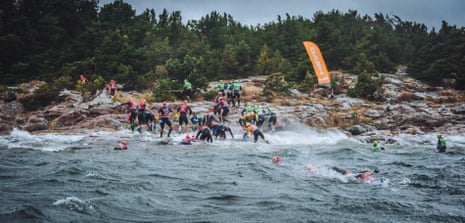From the sky, the Stockholm archipelago looks benign. More than 30,000 islands spread off the Swedish coastline in the Baltic Sea. In the Summer, they’re the islands of love, packed with holidaymakers. Today, it’s early September and the weather is a little rough: winds, swell and constant rain.
I’m on a safety boat, following the progress of one of the world’s toughest adventure races, the ÖtillÖ (“ö till ö”, or island to island), where participants racing as a team of two must run and swim across 26 of the islands, from Sandhamn to Utö. A total of 75km, if you manage to navigate the currents and rocks in a straight-ish line.
They call this a swimrun. A race that alternates multiple times between swimming and running. You can’t stop and change kit during the race, which means running in your wetsuit – usually cut above the knee – and swimming with your shoes on. It might sound odd, but the chance to race across rugged and often wild landscapes easily makes up for this inconvenience.
Six years ago the sport didn’t even exist. There was just the ÖtillÖ race, invented by a group of Swedes on Utö looking for a challenge. But as word of the annual event spread, it picked up imitators and, through one of its early competitors Erika Rosenbaum, the name swimrun.
Now it’s one of the fastest growing endurance sports in the world, with more than 100 events in Europe alone. The world’s best teams still come back to the ÖtillÖ every year, either through qualifying events or a lucky ballot, for what is classified as the swimrun world championship.
I had tried out a shorter version of the course two days before the race with one of the ÖtillÖ founders, Jesper Andersson. The race had originated as a challenge between Andersson, his brother and two other friends, competing in pairs, to beat each other to reach the island of Sandhamn. That spirit of camaraderie and teamwork, as well as safety, is the reason the majority of swimrun events continue as team-only races.
The other tactic most teams use is to keep a line between each other. Under race rules, competitors can’t be more than 10 metres apart at any point in time. For the swim, especially on a day of rough seas, this makes sense as an elastic rope keeps you from drifting apart and also allows one to draft the other, saving energy.
But being in a pair doesn’t stop things going awry. A large chunk of our time watching the race was spent chasing after competitors swimming in the wrong direction. The problem point for many was the so-called ‘pig swim’. A mile long stretch of open sea from the islands of Mörtöklobb to Kvinnholmen notorious for its difficulty. With winds of 20 knots, countless teams were thrown off-course by waves and currents. They look startled and disoriented as Andersson shouted at them from the safety boat.
The harsh weather did not relent from dawn to dusk. We could only watch in sympathy as teams coming off a later swim beached themselves on rocks. Tired from their exertions in the sea, they had aimed for the first rocky outcrop. It was a false hope. They faced either a slippery time-wasting traverse to the shore, or jumping back into the sea and trying to fight their way through waves to an easier exit point closer to land.
“These are good athletes, but they are getting stressed as things don’t go to plan. That’s the challenge of this sport,” said Andersson, “It’s not just about how fast you can run or swim, but about how you deal with the elements and manoeuvre into and out of the water.”
I’d had my own lesson two days earlier after confidently taking the lead on a shorter swim section. I was roughly following the direction of a team just ahead before losing sight of them. As I neared the shoreline rocks on the other side, I heard laughing behind and a tug on the rope. I’d taken the wrong route around a tiny rocky island outcrop and was now engaged in a futile attempt at swimming against a current to get to a shoreline less than 20 metres away. Andersson pointed to the nearest rocks and said we had better exit there and make our way back to the course.

Back on land wasn’t the easy part for competitors. The longest run was just under 20km, with the terrain a mix of rocks, woodlands and hills. There were directional markers on the course, but sometimes you had to pick your own route over sections. Mistakes can quickly lead to an argument for the team that ends up in bog or making an unnecessary detour.
Given the ordeal that faced them, it was surprising to discover later that only 30 of 148 teams starting the race had failed to make the finish, missing cutoff times or pulling out on the course. The winning team – a pair of Swedes whose men and women dominate the sport – made it home in under eight hours. A record despite the hostile weather.
After them the real story of swimrun was taking place, with teams crossing the finish line locked in an embrace, tears of joy and relief. It was near darkness for the final team, home after almost 14 hours of racing, a gentle hand on the lower back helping to propel a clearly exhausted teammate to the end.

Comments (…)
Sign in or create your Guardian account to join the discussion